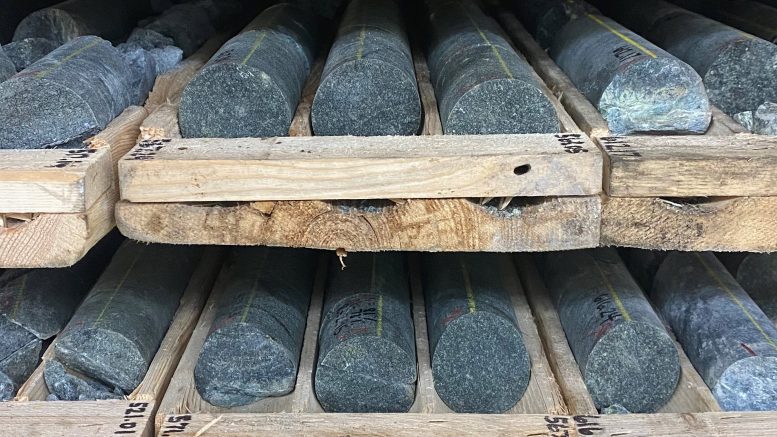Canada Nickel Company (TSXV: CNC) has discovered two new palladium-platinum zones and extended nickel mineralization at its wholly owned Crawford nickel-cobalt project located in the Timmins-Cochrane mining camp, 40 km north of Timmins, Ontario.
Discovery holes drilled in the East zone at the property have doubled the strike length of the nickel mineralization, while partial assays from a third hole have extended the PGM zone on the Main zone, the company reports.
“Crawford just keeps getting bigger and better as we move forward,” Mark Selby, the company’s chairman and CEO, said in an interview. “It’s pretty amazing that after we’ve already drilled off the eleventh largest nickel-sulphide resource globally, that with our first step-out holes from this anomaly we get the best nickel intersection and best palladium-platinum intersection to date.”
The first two discovery holes, 19-28 and 19-31, were drilled along the East zone and intersected nickel mineralization over 300 metres wide. This confirms that the zone is a faulted continuation of the Main zone and doubling the strike length of the known nickel mineralization by 1.7 km to a total of 3.4 km, Selby said.
Hole 19-28 returned the highest grade nickel to date, said Selby, intersecting 55 metres grading 0.42%, 0.13 gram palladium per tonne and 0.07 gram platinum per tonne starting from 407 metres downhole, including 257 metres grading 0.30% nickel, 0.03 gram palladium and 0.02 gram platinum from 317 metres downhole.
The second hole, 19-31, cut 29 metres grading 0.31% nickel, 0.02 gram palladium and 0.01 gram platinum from 305 metres downhole.

Mark Selby, chairman and CEO of Canada Nickel, holding core from the Crawford project in Ontario
“For us, what was most important was to define the high-grade material, as well as expanding the project,” Selby said. “It’s a testament to the size and scale of this project, and our confidence in the resource, that we can make one-kilometre-plus step-out holes, when you see some other nickel sulphide projects doing only 10- and 20-metre step-outs.”
The discovery at the East zone, he added, has only been tested for 1.7 km for an interpreted strike length of 2.6 km, while the Main zone remains open to the west and at depth.
Both holes also intersected palladium-platinum mineralization located at the north contact between the peridotite and pyroxenite layer directly to the north of the main nickel structure, Selby said.
“Because drilling worked out so well on the main structure, this allowed us to drill step-out holes to target various other pieces of the structure,” he said.
The drill program confirmed the presence of a PGM zone adjacent to the East zone nickel mineralization, with 19-28 intersecting 5 metres grading 0.8 gram palladium and 0.9 gram platinum from 180 metres downhole and 19-31 cutting 3 metres grading 0.7 gram palladium and 0.9 gram platinum.
The third drill hole, 20-32, was drilled at the north-eastern end of the Main zone and approximately 1.5 km from the nearest hole, extending the PGM zone 1.5 km along the strike length.
“We haven’t issued partial holes to date, but the PGM zone was a surprise as we stepped out from the Main zone and was sitting about 100 metres parallel to the nickel zone,” Selby said. “As with the nickel zone, we felt very comfortable stepping out to test the continuity of this PGM zone, and were very pleased to find that it intersected the PGM zone, not just once, but there seems to be a repeating sequence.”
The hole cut through three separate palladium-platinum zones, with partial assay results from the most promising intersect cutting 8 metres grading 1.3 grams palladium and 1.3 grams platinum starting from 123 metres.
The company is waiting for assay results from a further nine holes drilled in the East zone, which, Selby said, could further extend the mineralization identified to date.
“As a near-term goal, we’ll be looking to define an initial resource on East zone, to have our mineral resource update out by July, and to have completed a scoping study by year-end,” he said.
The company has two drill rigs operating in the East zone and PMG zone, Selby added, which will continue to drill-out the nickel and step-out on the PGM targets.
At press time in Toronto, Canada Nickel Company was trading at $1.32 per share within a 52-week trading range of 38¢ and $1.41.
The company has around 67 million common shares outstanding for a $88.4-million market capitalization.


Be the first to comment on "Canada Nickel discovers PGM zones at Crawford"